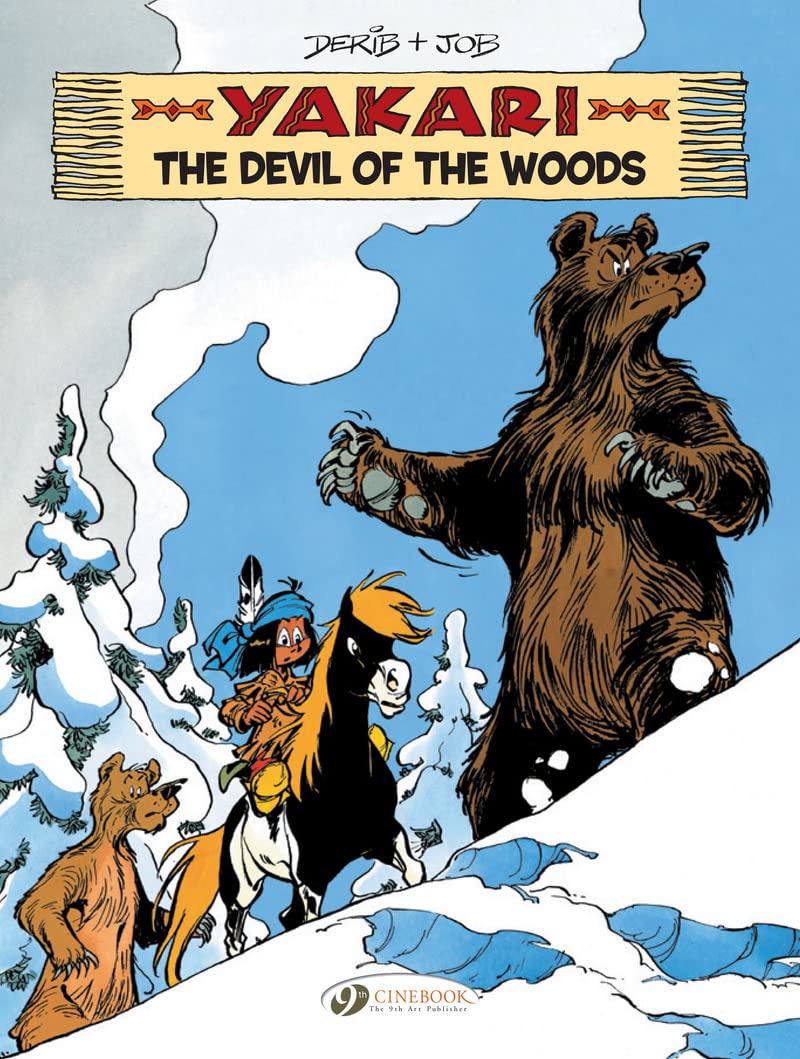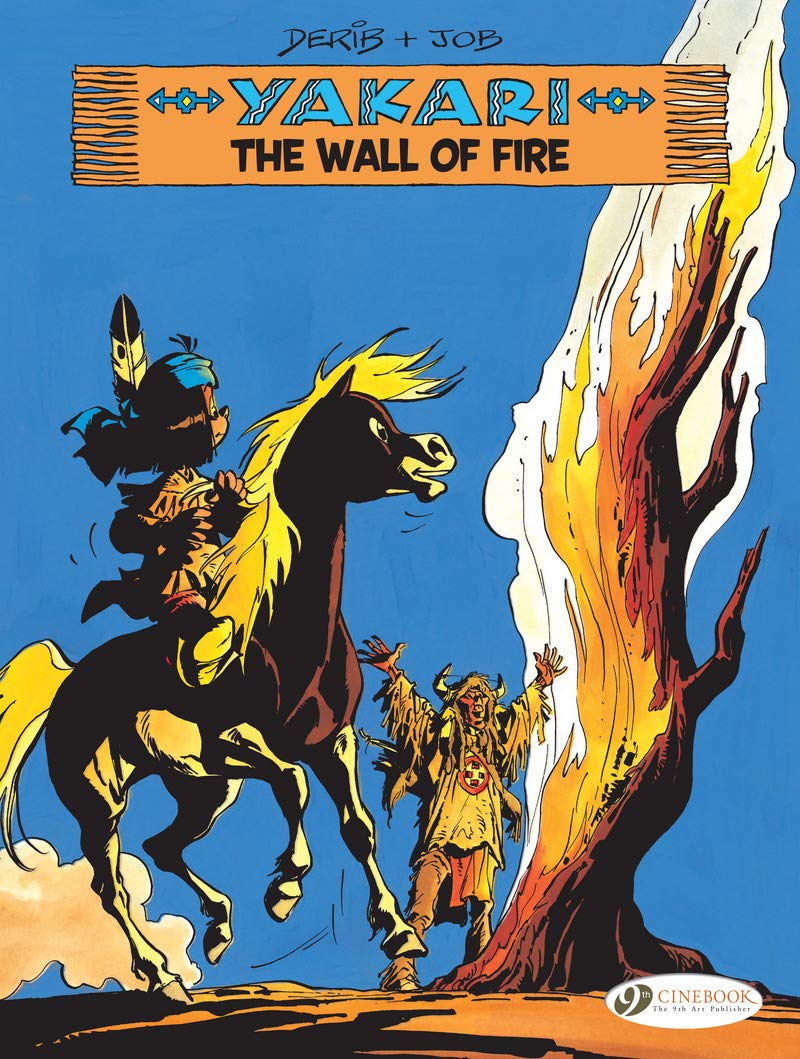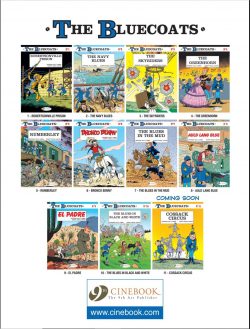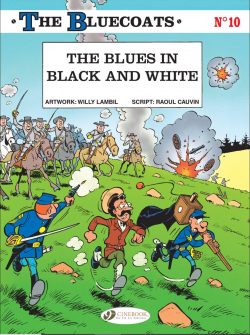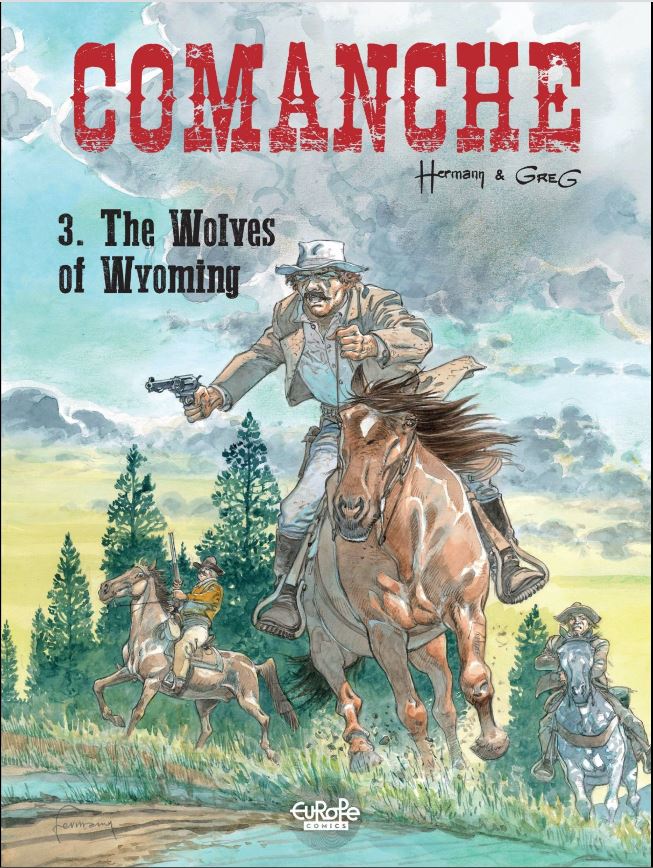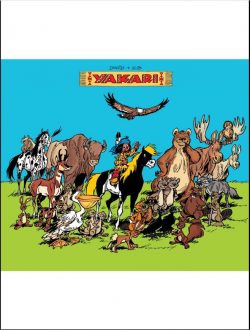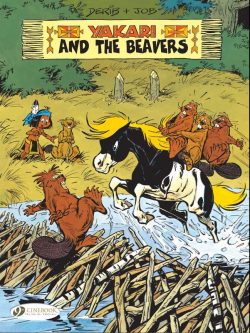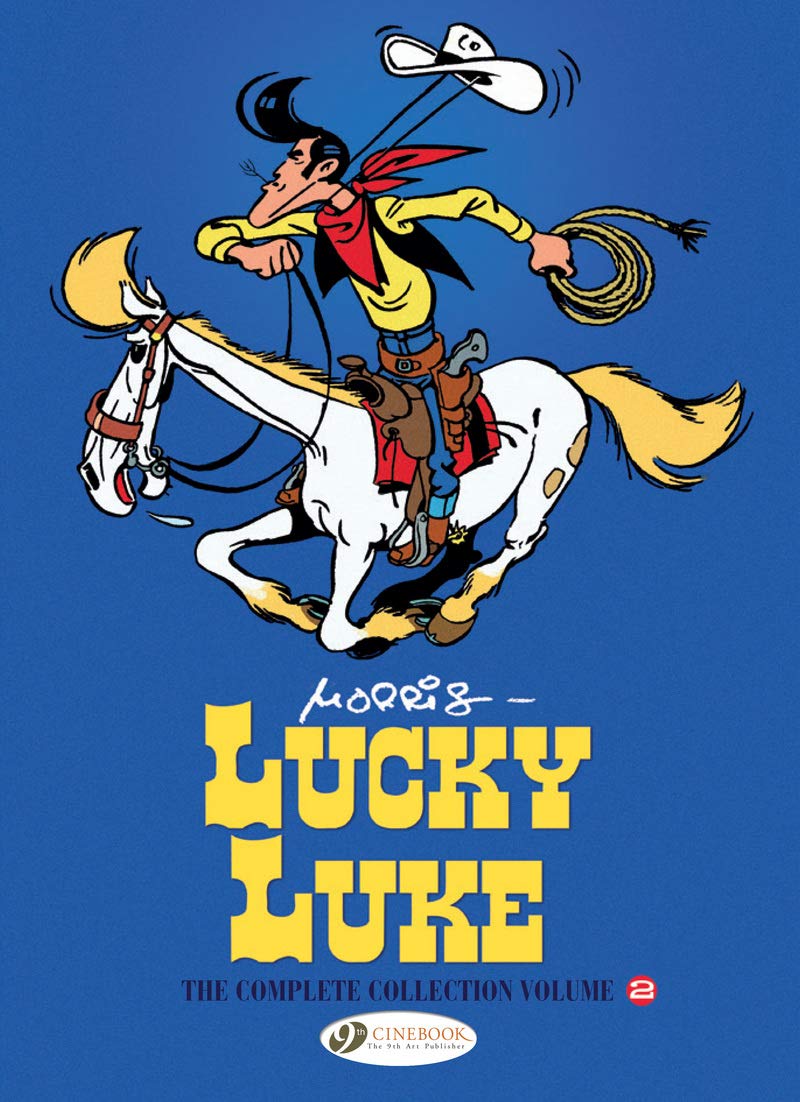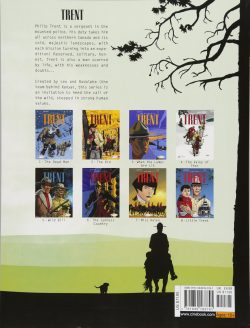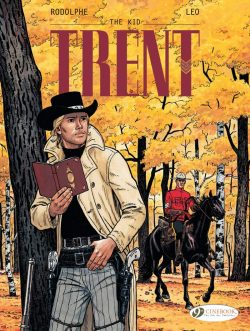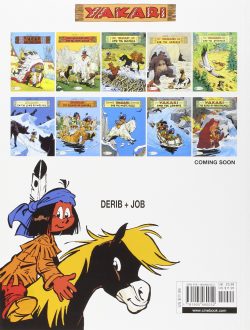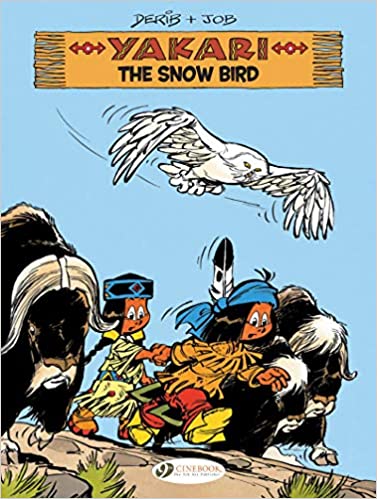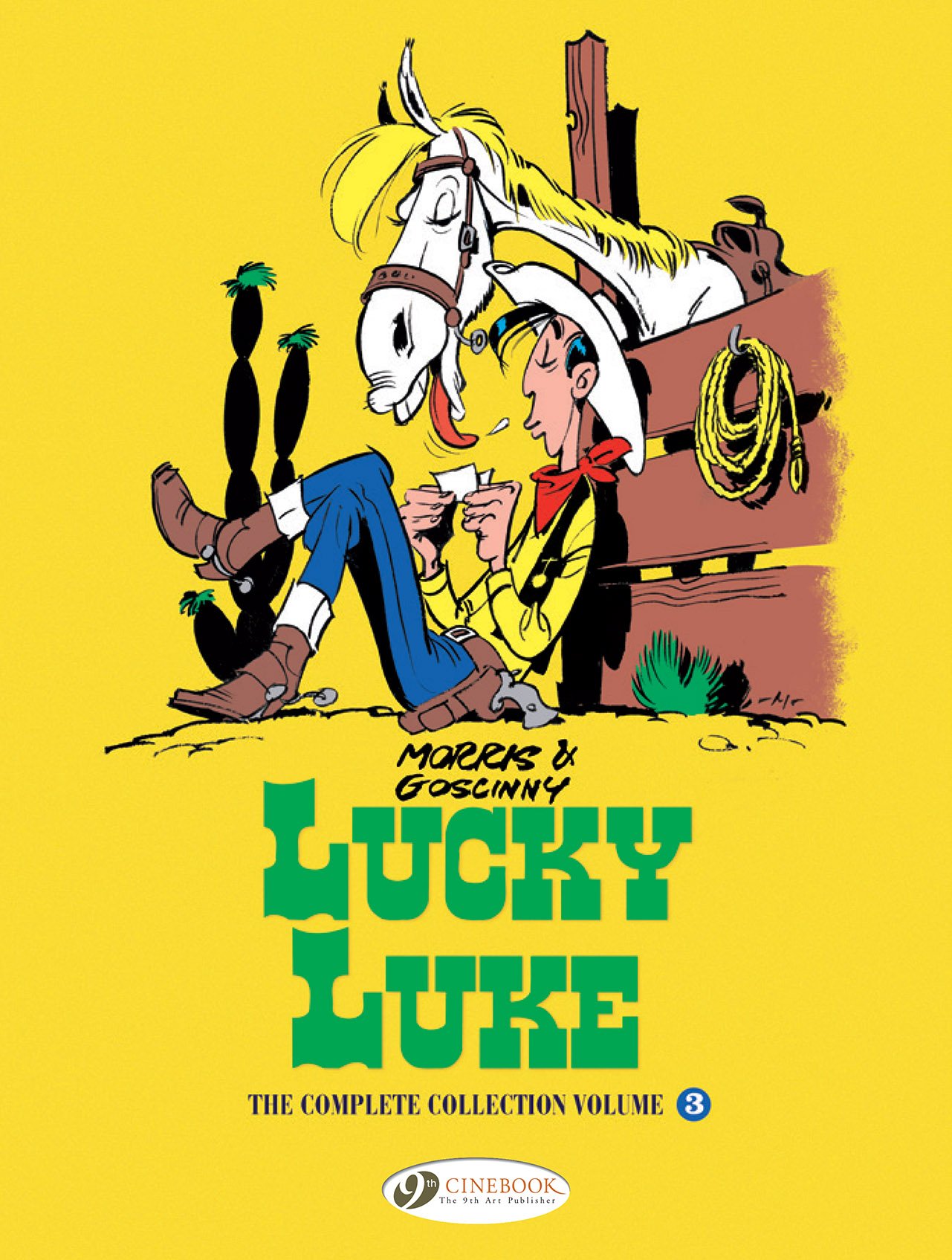
By Morris, with René Goscinny; translated by Jerome Saincantin (Cinebook)
ISBN: 978-1-84918-455-7 (Album HB)
Win’s Christmas Gift Recommendation: Blockbuster Thrills No Movie Could Match… 8/10
On the Continent, the populace has a mature relationship with comics: according them academic and scholarly standing as well as meritorious nostalgic value and the validation of acceptance as an art form. Whilst tracing the lost origins of a true global phenomenon, this hardback and digital compilation celebrates the formulative early triumphs of a fictional hero who is certainly a national treasure for both Belgium and France, and it’s also timely in that this worldwide western wonder celebrates his 75th Anniversary this year…
As we know him now, Lucky Luke is a rangy, good-natured, lightning-fast cowboy roaming the fabulously mythic Old West, having light-hearted adventures with his horse Jolly Jumper whilst interacting with a host of historical and legendary figures and icons.
His ongoing exploits have made him one of the best-selling comic characters in Europe (upwards of 80 collected books, plus spin-off series, archival collections and specials, translated into more than 300 million albums in at least 33 languages thus far). He’s also accrued all the usual merchandise spin-offs: toys, computer games, puzzles, animated cartoons, TV shows and live-action movies.
Lucky debuted in 1946, courtesy of Belgian animator, illustrator and cartoonist Maurice de Bévère (“Morrisâ€). For many years we all believed his first appearance was in a Le Journal de Spirou Christmas Annual – L’Almanach Spirou 1947 – before being catapulted into his first weekly adventure ‘Arizona 1880’ on December 7th 1946.
However, the initial volume in this superb archival series (in hardback album and digital editions) revealed the strip actually premiered earlier that year in the multinational weekly comic, but without a title banner and only in the edition released in France…
This third curated outing exhibits – in strict chronological order – strips created between December 1952 and February 1955, with all the art and pages here restored, rejiggled and remastered to achieve maximum contemporary authenticity with the original weekly serialisation. The stories were subsequently gathered as albums L’Élixir du Docteur DOXEY (November 1955, with successive volumes launching every year in that month), Lucky Luke contre Phil Defer (1956) and Des rails sur la Prairie (1957) and this tome even offers a little something extra at the end…
Previous volumes have detailed Morris’s life, career, and achievements, paying particular attention to his alternate duties as an illustrator and caricaturist for magazine Le Moustique and at the CBA (Compagnie Belge d’Actualitiés) cartoon studio, where he met future comics superstars Franquin and Peyo.
Morris was one of “la Bande des quatre†– The Gang of Four – comprising Jijé, Will and Franquin: leading proponents of a new, loosely free-wheeling artistic style known as the “Marcinelle School†which dominated Le Journal de Spirou in aesthetic contention with the “Ligne Claire†style used by Hergé, EP Jacobs and other artists in Le Journal de Tintin.
In 1948 said Gang (all but Will) visited America, meeting US creators and sightseeing. Morris stayed for six years, meeting fellow émigré René Goscinny, scoring work at newly-formed EC sensation Mad and constantly making copious notes and sketches of the swiftly vanishing Old West.
His ongoing works are further detailed and his “American Period†is extensively explored here in another lavishly illustrated essay from researchers Christelle & Bertrand Pissavy-Yvernault, who relate the Morris family’s jaunts and travels, paying particular attention to the movies they saw and how cinematic flourishes were transformed and recycled on the pages of Lucky Luke. Also on view are examples of work done for American consumption, such as children’s book Puffy Plays Baseball.
Crucially, there’s a detailed section on Goscinny, featuring his artwork – like so many, he was originally a cartoonist who realised his true strengths were plots and words – and side gigs in the USA: foreign correspondent, copywriter, business manager and more. At this time he created evergreen kids feature Le Petit Nicolas with Sempé in Le Moustique and his partnership with Morris formally began. What began as casual assistance eventually became a team effort that changed both their lives after they returned to Europe…
Accompanied by published cartoons and covers, contemporary ads, family photos and tons of original art, the in-depth treatise also focuses on the how and why of edited comics pages; reveals the artist’s film memorabilia (from movies that especially influenced his stories in this collection) and also includes both artwork from European and US publications by Goscinny. There’s even an in-depth analysis of how What Morris Saw became What Lucky Did, closely referencing the comics stories that follow…
Working solo (with early script assistance from his brother Louis De Bevere) until 1955, Morris produced nine albums of affectionate sagebrush parody and action before uniting with Goscinny, who became the regular wordsmith as Luke attained the dizzying heights of superstardom, commencing with Des rails sur la Prairie (Rails on the Prairie), in Le Journal de Spirou in August 1955.
Before we get there though, there’s all-Morris action to enjoy, starting with Doc Doxey’s Elixir which was originally serialised in Le Journal de Spirou #765-808, from December 11th 1952 to 8th October 1953. It relates the predatory journeys of a charlatan physician dispensing disgusting and often lethal liquid cure-alls, aided and abetted by his athletic stooge Scraggy, who gulls the public with his disguises and semi-miraculous instantaneous “recuperations†and fast exits.
Their pernicious peregrinations come to an end after poisoning the frontier town of Green Valley, which puts dogged Lucky on their trail. Packed with classic and episodic chase gags, the hunt concludes with the sneaky snake oil peddler behind bars. Of course, he doesn’t stay there long as sequel saga ‘Manhunt’ details his cunning escape, change of identity – but not modus operandi – and ultimately unsuccessful plot to murder the wandering cowboy…
Follow-up album Lucky Luke contre Phil Defer (or Lucky Luke: Phil Wire in Britain) also comprised two tales, but this time taken from the company’s general entertainment periodical. It introduced deadly gunslinger Phil Wire “The Spider†– based on legendary cinematic bad man Jack Palance – in a strip taken from Le Moustique #1464-1494 (14thFebruary-12th September 1954).
Phil Defer “LE FAUCHEUX†sells his lethal talents to sinister saloon owner O’Sullivan who’s looking to remove a rival. Fate – or perhaps the gods of comedy – unfortunately decree that another tall guy good with guns gets to Bottleneck Gulch first and is mistaken for the rather idiosyncratic notoriously superstitious killer…
Lucky and Wire have already clashed once before and – despite all the hero’s efforts to deter O’Sullivan – meet once more after all “the Spider’s†schemes to remove rival barkeep O’Hara are foiled. It comes down to a showdown on main street and only one man walks away…
The album also features a second serial from Le Moustique #1508-1516 (spanning 19th December 1954 to 13th February 1955): originally entitled Lucky Luke et Pilule.
As Lucky Luke and The Pill it here details a camp fire story told by the rangy gunman, relating how a short-sighted, diminutive hypochondriac tenderfoot with no discernible fighting ability or action acumen became a true gun-toting town-tamer…
It was back to Le Journal de Spirou for the final album reprinted here: gathering material from #906-929 and spanning 25th August 1955 to 2nd February 1956 before launching in November 1957 as ninth album Des rails sur la Prairie. Although uncredited, it was cowritten by Morris and fellow tourist Goscinny: auguring an astounding creative partnership to come…
In 1967 the six-gun star switched publishing teams, transferring to Goscinny’s own magazine Pilote with La Diligence (The Stagecoach). Goscinny produced 45 albums with Morris before his death, from whence Morris continued both singly and with fresh collaborators.
Morris died in 2001 having drawn fully 70 adventures, plus the spin-off adventures of Rantanplan (“dumbest dog in the West†and a charming spoof of cinema canine Rin-Tin-Tin), with Achdé, Laurent Gerra, Benacquista & Pennac taking over the franchise, producing another five tales to date.
Also in 1967, Lucky Luke appeared in British comic Giggle where he was renamed Buck Bingo. He had previously been seen here in weekly comic Film Fun. Before all that, though, this wild and woolly transitional delight features a far more boisterous and raw hero, offering the lighter side of another mythic western scenario…
When track-laying for the Transcontinental Railroad stalls, outraged train moguls demand action and Dead Ox Gulch, Nebraska becomes the crunch point of confrontation. The construction problems are actually caused by a traitor at home. Although a board-member in good standing Black Wilson is also secretly sabotaging the project to protect his other business: a stage coach company…
He contacts the nefarious Wilson Boys gang to keep up the bad work, just as a tall, laconic stranger rides into town. Before long, he is spearheading the march of progress and civilisation by foiling every dirty trick the gang can conceive…
Once the renewed efforts have moved beyond town and onto the prairie and inching closer to California, a train carries Lucky, passengers and the navvies ever-westward, negotiating and stymying hostile natives, greedy townships and the still-active Wilson boys’ shady tactics and stratagems.
Ultimately, Black Wilson takes personal charge and boards a stagecoach westward to destiny. Despite his every trick, though, the showdown is a foregone conclusion…
Adding extra value here is a short Luke lark that first appeared in Risque-Tout #5 (December 1955). A monochrome vignette, ‘Ruckus in Pancake Valley’ has been redrawn and coloured here and details how Lucky tracks down a miscreant who stole his horse…
Packed with contemporaneous extras, commentary, creator biographies, a special ‘Christmas in the Far West’ feature and more, this is perfect for older kids who have gained a bit of historical perspective and social understanding, although the action and slapstick situations are no more contentious than any Laurel and Hardy film – perfectly understandable as Morris was a huge fan of the duo. These early exploits are a grand old hoot in the tradition of Destry Rides Again or Support Your Local Sheriff, superbly executed by a master storyteller, and a wonderful introduction to a unique genre for modern kids who might well have missed the romantic allure of the Wild West that never was…
Bon Anniversaire, Lucky!
All pages relating to Doc Doxey’s Elixir, Phil Wire and Ruckus in Pancake Valley are © Morris/Dupuis 2018. 1949 to 1954 for the first publications in Le Journal de Spirou. All pages relating to Rails on the Prairie © Morris/Goscinny/Dupuis 2018. English translation © 2019 Cinebook Ltd.
